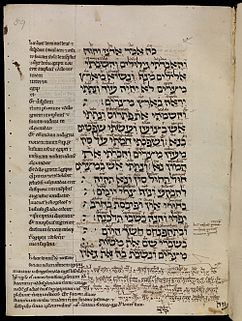Ezekiel 4 is the fourth chapter of the Book of Ezekiel in the Hebrew Bible or the Old Testament of the Christian Bible.[1] This book is one of the Books of the Prophets and contains the prophecies attributed to the prophet/priest Ezekiel.[2] In this chapter, following God's command, Ezekiel performs a sign-act, a symbolic representation of the siege of Jerusalem and resulting famine.[3]
| Ezekiel 4 | |
|---|---|
 Book of Ezekiel 30:13–18 in an English manuscript from the early 13th century, MS. Bodl. Or. 62, fol. 59a. A Latin translation appears in the margins with further interlineations above the Hebrew. | |
| Book | Book of Ezekiel |
| Hebrew Bible part | Nevi'im |
| Order in the Hebrew part | 7 |
| Category | Latter Prophets |
| Christian Bible part | Old Testament |
| Order in the Christian part | 26 |
The original text was written in Biblical Hebrew. This chapter is divided into 17 verses.
Some early manuscripts containing the text of this chapter in Hebrew are of the Masoretic Text tradition, which includes the Codex Cairensis (895), the Petersburg Codex of the Prophets (916), Aleppo Codex (10th century), and Codex Leningradensis (1008).[4] Fragments containing parts of this chapter were found among the Dead Sea Scrolls including 1Q9 (1QEzek; Pre 68 CE) with extant verses 15–17;[5][6][7][8] and 11Q4 (11QEzek; 50 BCE–50 CE) with extant verses 3–6, 9–10.[5][6][9][10]
There is also a translation into Koine Greek known as the Septuagint, made in the last few centuries BC. Extant ancient manuscripts of the Septuagint version include Codex Vaticanus (B; B; 4th century), Codex Alexandrinus (A; A; 5th century) and Codex Marchalianus (Q; Q; 6th century).[11][a]
This part describes how Ezekiel enacts the Siege of Jerusalem, by first drawing a map of Jerusalem on a clay tablet or a brick, then building a model of the siege apparatus encircling the model city, and finally setting up an iron plate as a wall between the city and himself, facing the city to start the siege to it.[3]
In this part, Ezekiel acts out the role of Jerusalem's citizens, eating meager rations of food to symbolize famine, even baking cakes over dung to emphasize the severity.[20]